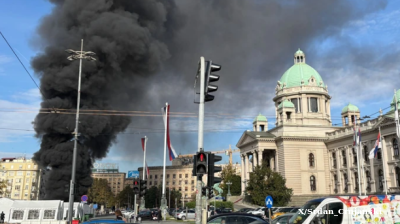Air pollution from coal-fired power plants in the Western Balkans have caused the deaths of around 19,000 people over the last three years, according to a report from CEE Bankwatch Network and the Centre for Research on Energy and Clean Air (CREA).
Almost 12,000 of those who died – 3,700 in the Western Balkans and 7,000 in the EU – did so as a result of Western Balkan coal power plants breaching pollution limits between 2018 and 2020, said the report, ‘Comply or Close: How Western Balkan coal plants breach air pollution laws and cause deaths and what governments must do about it’. Another thousand more people are estimated to have died in other regions.
The single worst affected country was Italy, across the Adriatic from the region, where 605 deaths were attributed to emissions caps being exceeded, followed by Serbia (600), Hungary (390), Romania (360) and Bosnia & Herzegovina (280).
Financially, the authors estimate that by breaching emissions limits, Western Balkan coal power stations caused health costs of between €6.0bn and €12.1bn in the three-year period, of which almost three-quarters were in borne by the EU and a further 21% in the Western Balkans. Costs include personal costs for medical treatment, increased national healthcare budgets and reduced productivity.
The projections of how many deaths could have been avoided by cutting air pollution from Western Balkan coal power plants are based on earlier studies showing the increased risk of death from chronic diseases among people living in areas with higher average concentrations of air pollution, combined with population data and observed numbers of deaths. According to the research, the lost number of life years associated with each air pollution-related death in Western Balkans is around 20 years.
“12,000 of those deaths would have been avoided if emissions ceilings had been respected,” Lauri Myllyvirta, lead analyst at CREA, told a press briefing ahead of the report’s release. “There is also a long list of other health impacts – working days lost, asthma and bronchitis in children, hospital emissions and low birth rates. We are also starting to see evidence of how air pollution affects the risks and outcomes of COVID-19 infections.”
Emissions of sulphur dioxide (SO2) and other harmful substances should have been bought down from the beginning of 2018, when countries that are party to the Energy Community Treaty (ECT) were supposed to comply with an adapted version of the EU Large Combustion Plants Directive, an EU directive to reduce emissions of dangerous substances. “For the past three years, new air pollution standards should have brought reductions in harmful emissions from coal plants across the Western Balkans. But in 2020, sulphur dioxide emissions from coal power plants across the region still flagrantly breached these legal limits,” said the press release from CEE Bankwatch and CREA.
As EU countries have been working to reduce emissions with a view to phasing out coal altogether and achieving climate neutrality for the bloc by 2050, the discrepancy between the bloc and aspiring members in the Western Balkans has widened.
The Western Balkans has just 18 coal power plants, but those 18 emitted two and half times as much SO2 as all 221 coal power stations in the EU combined in 2020, says the report. Serbian coal power stations subject to the National Emissions Reduction Plan (NEPIs) alone emitted more SO2 than all the coal power plants in the EU in 2020. Coal-fired power plants in Serbia, Bosnia, North Macedonia and Kosovo – the four countries that have NERPs – have been emitting least six times the legal limit of SO2 since 2018.
The single worst polluter in the region was Bosnia’s Ugljevik power plant, whose emissions exceeded the combined SO2 ceiling for all four countries. Despite this, there are plans to add a further 700 MW of new lignite capacity at the power plant.
At the online briefing, Pippa Gallop, Southeast Europe energy advisor at CEE Bankwatch Network, said that while countries from the Western Balkans had years to comply with the Large Combustion Plant Directive, little was done ahead of 2018. This resulted in emissions from the coal plants included in the NERPs soaring through the allowed limit 2018 and 2019. While there were hopes that emissions might have fallen during the pandemic year of 2020, this proved not to be the case. Instead, SO2 emissions rose to 6.4 times the allowed limit, and were 2.5 times as high as those from all coal plants in the EU.
All of the four countries in the region that have NERPs currently face Energy Community dispute settlement cases for failing to comply with the pollution limits in the NERPs in 2018 and 2019, and a dispute settlement case was also opened against Montenegro in April 2021 after the Pljevlja power plant continued operating beyond its 20,000 hours quota under the Large Combustion Plants Directive’s limited lifetime derogation, according to the report.
The only bit of better news was that nitrogen oxides (NOX) emissions for the region were below the sum of the countries’ ceilings for 2020, although both Bosnia and Kosovo breached their national ceilings.
Gallop noted that two of the most polluting coal-powered plants in the region had announced desulphurisation plans, but these have not yet yielded results. “A desulphurisation facility was installed at Ugljevik, and was supposed to [have been] finished in 2019 or early 2020. However, in March 2020 they revealed technical problems and one and a half years since then there has been all kinds of prevarication and basically nothing happened. … Unfortunately there is a very similar situation at Serbia’s Kostolac B, where a desulphurisation facility was declared finished in 2017, but then nothing happened,” she said.
Supplying the EU
Energy from coal-fired power plants in the region doesn’t just supply domestic users; some is traded with the EU – a net importer of electricity – as well. In total, the Western Balkans exported 25 TWh of electricity into the EU between 2018 and 2020, or 8% of total coal-fired power generation in the Western Balkans.
In 2020, the electricity generated by these coal plants and traded with the EU only accounted for a tiny fraction of EU electricity consumption (0.3%), but still produced as much SO2 as half of the EU’s coal power plants combined. This means, says the report, that the EU "bears not only much of the health costs of coal power generation in the region, but also some of the responsibility.”
“The EU’s imports of electricity from the Western Balkans make up only 0.3% of the EU’s total electricity consumption, but the SO2 emissions associated with these imports equal 50% of the entire SO2 emissions from all power plants in the EU in 2020,” says the report.
“This is because power generation in the Western Balkans is around 300 times more SO2-intensive than in the EU. For this reason, and since the countries are aspiring EU members, EU action to tackle air pollution inevitably needs to include the Western Balkans as well.”
Janez Kopac, director of the Energy Community Secretariat, describes the exports of “dirty electricity” from the Western Balkans to the EU as “environmental dumping and health dumping”, which is “simply a violation of the trade rules”. While carbon dioxide (CO2) prices have risen in the EU this year, the Western Balkans has no CO2 price, which means that for local power generators supplying to the EU, “the profits are enormous”.
“Last year consumption dropped but generation from coal plants in the Western Balkans increased because it was so profitable,” commented Kopac, who called on the EU to use its soft power in the region more intensively.
Meanwhile, Denis Zisko, energy and climate change programme coordinator at the Center for Ecology and Energy Tuzla, argued that soft power will not sway local politicians who control the state-owned power plants in the Western Balkans, many of which are subsidised to keep electricity prices artificially low for the population. However, he points out, “we are actually subsidising the electricity which is exported to the EU, which is ridiculous. If there were no subsidies, and real market prices, there would be no exports because the electricity would become too expensive.”
“As our report shows, when the EU trades electricity with its Western Balkan neighbours, it bears both the impacts and part of the responsibility for the resulting out-of-control air pollution. The EU must also help countries in the Western Balkans to move beyond coal by taxing fossil-fuel based electricity imports and ensuring effective enforcement of the Energy Community Treaty,” said Myllyvirta.
News

Asian carrot smuggling ring busted in the Philippines
The cargo, consigned to Fourth Consumer Goods Trading, contained more than 53,000 kilograms of carrots that were already beginning to rot.

India, US near major trade deal cutting tariffs to 15–16% if New Delhi will limit Russian crude imports
India and the United States are close to finalising a long-awaited bilateral trade deal that could sharply lower tariffs on Indian exports to about 15–16% from the current average of 50%

Mongolia’s PM to stay in power after court rules dismissal illegal
Observer says opponents of Zandanshatar Gombojav “rushed and sloppily handled motion” to dislodge him. Second attempt to vote him out not expected.
_1761147529.jpeg)
China accuses Washington of “bullying” over visa ban threats in Central America
China has sharply criticised the United States for its decision to impose visa restrictions on Central American officials and citizens accused of ties to the Chinese Communist Party, describing the move as evidence of American “arrogance and bias."




